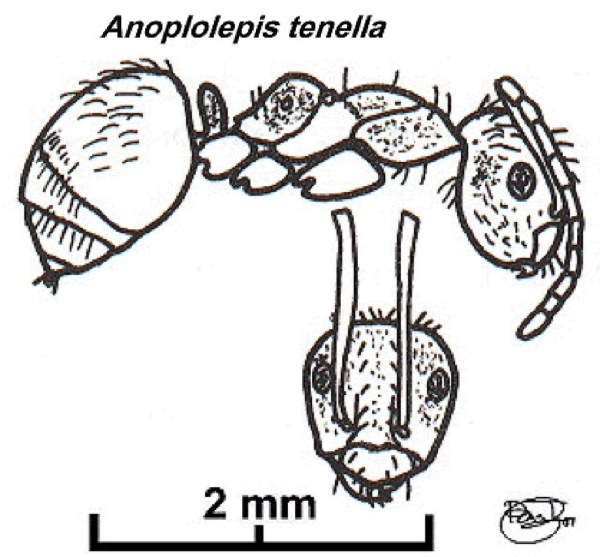Anoplolepis (Anoplolepis) tenella (Santschi)
  Type locality Congo (Plagiolepis
tenella n. sp., Santschi, 1911c: 363, worker, not illustrated)
collected
at Brazzaville, by Weiss, 1907, from the stomach of a pangolin - see below;
Wheeler, 1922a: 214, male & queen; in Anoplolepis, Emery,
1925b: 18); all forms described; in subgenus Anoplolepis
(Bolton, 1995) Type locality Congo (Plagiolepis
tenella n. sp., Santschi, 1911c: 363, worker, not illustrated)
collected
at Brazzaville, by Weiss, 1907, from the stomach of a pangolin - see below;
Wheeler, 1922a: 214, male & queen; in Anoplolepis, Emery,
1925b: 18); all forms described; in subgenus Anoplolepis
(Bolton, 1995)  . .
|
Santschi's (1911c) description is on -  . Santschi (1911g) reiterated the
description, this is on - . Santschi (1911g) reiterated the
description, this is on -  . Wheeler (1922a) noted the queen had been
reported by Forel but was not described; the male Wheeler gave as TL ca
5 mm, the wings ca 6 mm, the head only half as wide as the alitrunk,
wider than long, with small acutely 5-toothed mandibles; colour,
sculpture and pilosity as with the worker, but the head is dark brown
behind and the alitrunk shining, with three obscure brownish
longitudinal blotches on the mesonotum. . Wheeler (1922a) noted the queen had been
reported by Forel but was not described; the male Wheeler gave as TL ca
5 mm, the wings ca 6 mm, the head only half as wide as the alitrunk,
wider than long, with small acutely 5-toothed mandibles; colour,
sculpture and pilosity as with the worker, but the head is dark brown
behind and the alitrunk shining, with three obscure brownish
longitudinal blotches on the mesonotum.
|
 Nigeria
specimens (as Plagiolepis species T2,
Taylor, 1978: 43). WORKER TL 3.73 mm, HL 0.98, HW 0.90, SL 1.40, PW 0.65 Nigeria
specimens (as Plagiolepis species T2,
Taylor, 1978: 43). WORKER TL 3.73 mm, HL 0.98, HW 0.90, SL 1.40, PW 0.65
Colour golden-yellow, gaster darker and shiny, head and alitrunk dull
because of sculpturation of very fine reticulation. Erect hairs coarse,
brown and abundant on head and gaster. Promesonotal and metanotal
sutures marked, metathoracic spiracle raised, propodeum domed in
profile.
Collected by us from cocoa at Akure, Ondo State.
Found in pitfall traps, 47-82 individuals, in two cocoa
plots at Nko'emvon, Cameroun, by Jackson (1984, identified by
Bolton). The average of two individuals per trap suggests that they
forage singly.
Also known from Zaïre, where specimens were
found running on the ground in a native village (Wheeler, 1922).
Fotso Kuate et al (2008) recently described
aspects of A. tenella behaviour. They described it as a
ground-nesting ant of the tropical forest zone of Central Africa,
commonly associated with African root and tuber scale, Stictococcus
vayissieri Richard, an emerging cassava pest. [Geographically, I
would not describe the known locations as in "Central Africa"].
See: Fotso Kuate, A., Tindo, M., Hanna, R., Kenne, M. & Goergen, G.
2008. The foraging activity and diet of the ant, Anoplolepis tenella
Santschi (Hymenoptera: Formicidae), in southern Cameroon. African
Entomology, 16, 107-114. http://www.biogeography.unibas.ch/Publikationen/papers/FOTSO-KUATE_diet_anoplolepis_tenella_santschi.pdf.
|